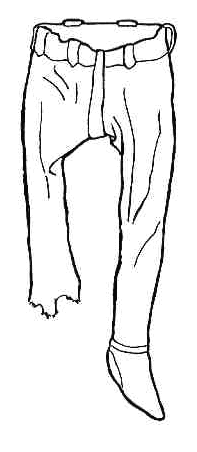
This document is provided as is without any express or implied warranties. While every effort has been taken to ensure the accuracy of the information contained, the author assumes no responsibility for errors or omissions, or for damages resulting from the use of the information contained herein.
Permission is granted to make and distribute verbatim copies of this document for non-commercial private research purposes provided the copyright notice and this permission notice are preserved on all copies. Website mirroring is permitted by express prior arrangement. Permission will only be granted if the document is posted in its entirety and the content and format of the document remain completely unaltered by the mirroring site. The definitive version of this document can be found at http://www.shelaghlewins.com.
Illustrations: Shelagh Lewins, based on those in Margrethe Hald's book.
Copyright © 2006 Shelagh Lewins.
Between 1851 and 1861, a significant quantity of items were found within an area of about half a square mile, in the Danish peat bog known as Thorsbjerg Mose.
Many of the finds had been deliberately damaged and they are thought to be votive offerings thrown into the bog after battles. They were deposited over a period of time spanning the early 2nd to early 5th centuries: most of the finds are from the 3rd century. The finds include weapons, tools, baskets, gaming pieces, pottery, textiles etc. Among the textiles were two rectangular pieces of woollen cloth thought to have been cloaks, a long-sleeved tunic and two pairs of trousers, one of which is almost complete and forms the basis of this document.
The trousers are on display at the Landesmuseum, Schloss Gottorf, Schleswig, Germany.
The trousers are almost completely undamaged, except that the lower right leg has been torn away.

Figure 1: the trousers
The remaining leg ends in a foot making the trousers resemble a romper suit. The foot section has a seam running along the sole from the toe to about the middle of the arch, where a gore has been inserted underneath the heel. A narrow strip of cloth attaches the foot to the leg.
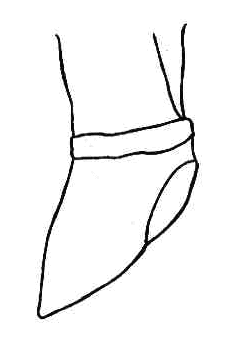
Figure 2: the foot
Although the trousers are around 1 metre in total length, the legs are very narrow, only about 30 cm around the calf.
A squarish trapezoid piece of cloth has been let into the seat, and a narrow trapezoid piece runs up the front of the trousers and divides the waistband.
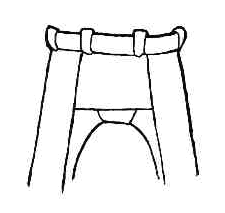
Figure 3: the back
There are six belt loops sewn to the outside of the waistband, and these are roughly cut with no sign of a hem. The waistband is sewn so that the right side of the cloth faces inwards, and this suggests that the waistband may have been folded over when worn. There would then be very little strain on the belt loops.
There is an opening in the back of the calf, round the back near the leg seam. This may have made it easier to get the foot through the narrow trouser leg.
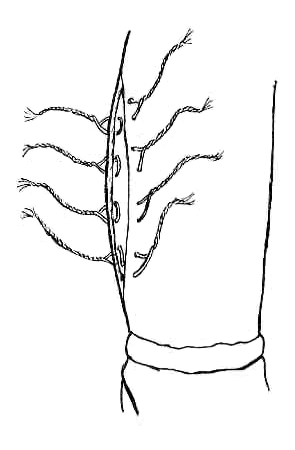
Figure 4: the leg opening
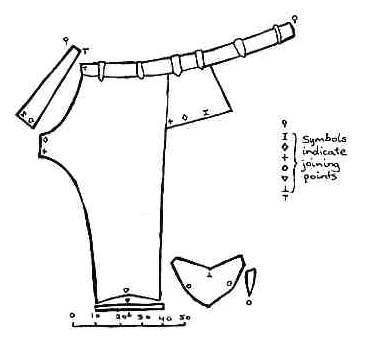
Figure 5: the pattern
The fabric is a fine diamond twill wool, which together with the complex cut suggests that the wearer of these trousers was not poor.
A number of fragments of cloth were used to caulk ships later sunk in Hedeby harbour, now in Germany. These included fragments which are thought to be the remains of the crotch of a pair of baggy men's trousers, similar in style to the crotch of the Thorsbjerg trousers, and possibly the remains of the crotches of several other pairs, narrow and baggy. Not much can be deduced about the overall construction of the Hedeby trousers, beyond the implication that the general construction method of the Thorsbjerg trousers persisted into the 10th Century.
These were recovered from another peat bog but have suffered more damage than the Thorsbjerg trousers. The lower legs have been torn away and it's not possible to tell whether they originally ended in cloth feet. They are also woven in a fine broken lozenge twill, presumably wool as linen is seldom preserved.
The seat of the trousers is made of a squarish piece of cloth and two triangular pieces provide fullness at the thigh. A U-shaped section at the front has been deliberately removed, leaving the trousers open at the front. As with the Thorsbjerg trousers, the legs are very narrow and straight.
The trousers from the Daetgen Mose are made from asymmetric and irregularly shaped pieces of lower-quality fabric. They are made from one large piece of cloth divided up to the crutch and with the divided sections folded over to make legs. The lower part of the leg seams have been left unsewn, leaving them slit from calf to ankle.
A separate seat panel has been inserted, relating the pattern to the Thorsbjerg and Damendorf pairs. In addition an extra piece of cloth has been sewn onto the outer edge of each side of the main piece to provide more width from about the knee upwards. There is no waistband.
The trousers from Marx-Etzel are similar but comprise just one large piece split to the crotch, and a seat panel.
Both pairs probably date from an earlier period, some time during the Iron Age.
We can't be sure, because there are no complete finds of trousers from the Viking Age. The Hedeby fragments suggest that the general construction method was along the lines of those described here, with a separate seat piece and probably (but not necessarily) a narrow piece up the crotch. There is no evidence to suggest that Vikings used a modern trouser pattern such as that found on jeans or the "pyjama" style.
The early style of trouser tends to provide more room for movement and be suitable for an active lifestyle. Practical experience shows that the Thorsbjerg style of trouser is less prone to "re-enactor's crotch" i.e. embarrassing splits, than those made from a modern pattern.